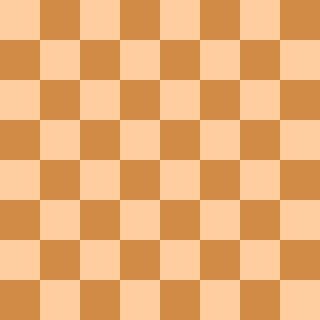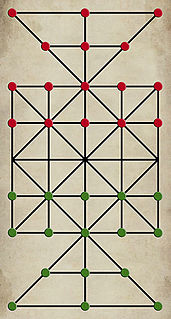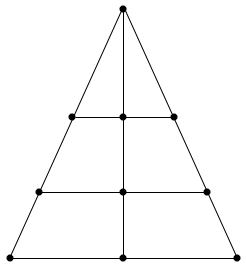
Sternhalma, commonly known as Chinese checkers or Chinese chequers, is a strategy board game of German origin which can be played by two, three, four, or six people, playing individually or with partners. The game is a modern and simplified variation of the game Halma.

Mak-yek is a two-player abstract strategy board game played in Thailand and Myanmar. Players move their pieces as in the rook in Chess and attempt to capture their opponent's pieces through custodian and intervention capture. The game may have been first described in literature by Captain James Low a writing contributor in the 1839 work Asiatic Researches; or, Transactions of the Society, Instituted in Bengal, For Inquiring into The History, The Antiquities, The Arts and Sciences, and Literature of Asian, Second Part of the Twentieth Volume in which he wrote chapter X On Siamese Literature and documented the game as Maak yék. Another early description of the game is by H.J.R. Murray in his 1913 work A History of Chess, and the game was written as Maak-yek.
Fox games are a category of asymmetric board games for two players, where one player is the fox and tries to eat the geese / sheep, and the opposing player directs the geese/sheep and attempts to trap the fox, or reach a destination on the board. In another variant, Fox and Hounds, the fox merely tries to evade the hounds. There are several versions known:
Three-player chess is a family of chess variants specially designed for three players. Many variations of three-player chess have been devised. They usually use a non-standard board, for example, a hexagonal or three-sided board that connects the center cells in a special way. The three armies are differentiated usually by color.
Rimau-rimau is a two-player abstract strategy board game that belongs to the hunt game family. This family includes games like Bagh-Chal, Main Tapal Empat, Aadu puli attam, Catch the Hare, Sua Ghin Gnua, the Fox games, Buga-shadara, and many more. Rimau-rimau is the plural of rimau which is an abbreviation of the word harimau, meaning 'tiger' in the Malay language. Therefore, rimau-rimau means 'tigers'. The several hunters attempting to surround and immobilize the tigers are called orang-orang, which is the plural of orang, meaning 'man'. Therefore, orang-orang means 'men' and there are twenty-two or twenty-four of them, depending on which version of the game is played. The game originates from Malaysia.

Bear games is a category of board games of which many have historical roots in the Roman Empire. They were played in parts of the Empire as far away as Turkey and France and are still played today, especially in Italy. All of the games are two-player abstract strategy board games. Normally, the game is played with three hunters and one bear on a patterned board. It bears similarity to the hunt games such as the Fox games, Rimau-rimau, and Bagha-Chall, however, there are no captures involved. The three hunters are trying to hem in the bear, and block its movements.

Lau kata kati is a two-player abstract strategy game from India, specifically from Lower Bengal, and also from United Provinces, Karwi Subdivision where it is called Kowwu Dunki, and it was described by H.J.R. Murray in A History of Board-Games Other Than Chess (1952). The game is related to draughts and even more so to Alquerque. Pieces are captured by leaping over them. The board is a pattern of two triangles joined together at a common vertex with further lines subdividing them. It is the same game as Butterfly (game) from Mozambique, which suggests a historical connection between the two games. Lau kata kati belongs to a specific category of games called Indian War-games, and the other games in this category are Dash-guti, Egara-guti, Pretwa, Gol-skuish. All Indian War-games have one important thing in common, and that is that all the pieces are laid out on the patterned board, with only one vacant point in the center. This forces the first move to be played on the central point, and captured by the other player's piece.
Egara-guti is a two-player abstract strategy game from India, specifically from Central Provinces, and it was described by H.J.R. Murray in A History of Board-Games Other Than Chess (1952). The game is related to Draughts and even more so to Alquerque. Pieces are captured by leaping over them. Egara-Guti consists of a Lau kata kati board, but with the addition of two lines connecting the two triangles and running through them. Egara-guti belongs to a specific category of games called Indian War-games, and the other games in this category are Lau kata kati, Dash-guti, Pretwa, Gol-skuish. All Indian War-games have one important thing in common, and that is that all the pieces are laid out on the grid patterned board in the beginning, with only one vacant point in the center. This forces the first move to be played on the central point, and captured by the other player's piece.
Hare games are two-player abstract strategy board games that were popular in medieval northern Europe up until the 19th century. In this game, a hare is trying to get past three dogs who are trying to surround it and trap it. The three dogs are represented by three pieces which normally start on one end of the board, and the hare is represented by one piece that usually starts in the middle of the board or is dropped on any vacant point in the beginning of the game.

Komikan is a two-player abstract strategy board game of the Mapuches from Chile and Argentina. The same game is also played by the Incas under the name Taptana, Komina, Comina, Cumi, Puma, or Inca Chess. In modern Quechua, the language of the ethnolinguistic group that are the descendants of the Incas, Taptana means "chess". It is known by the Aymaras, a neighboring ethnolinguistic group to the Quechuan people, as kumisiña. Throughout South America the game is known as El león y las ovejas which literally means "the lion and the sheep". The lion is actually a puma as there are no lions native to the Americas. The Mapuches also call it El Leoncito. J. I. Molina, in 1787, described it as ‘el artificioso juego del ajedrez, al cual dan el nombre de comican’ which translates to "the ingenious game of chess to which they give the name comican". Komikan may actually be the same game as Adugo as played by the Bororó people of Brazil. in 1898, Stewart Culin, the famed anthropologist, named a game played in Peru as Solitario. The same name was also used by the game historian, Murray, in 1952. The game may also be known in Peru as Kukuli. Komikan is a hunt game, and specifically a tiger hunt game since it uses an expanded Alquerque board. Like all hunt games, there are two unequal forces at play. In Komikan, one player has only a single piece, usually called a "puma" or "jaguar", or "kom ikelu", or "leon", which can move one space at a time or capture the other player's pieces by hopping over them. The other player has twelve pieces, or perros or perritos which is Spanish for "dogs" and "little dogs" respectively, that can only move one space at a time, but not capture, and attempts only to surround and immobilize the puma or jaguar. Pieces must move and/or capture following the pattern on the board. The expanded Alquerque board consist of an Alquerque board and a triangular patterned board attached on one of its side.
Len Choa is a two-player abstract strategy game observed in 19th-century Thailand. It is a Leopard hunt game. One tiger is going up against six leopards. The leopards attempt to surround and trap the tiger while the tiger attempts to capture enough of them so that the leopards can not immobilize the tiger. It is unknown how old the game is, however, the game was documented by Captain James Low in the 1839 periodical Asiatic Researches; or, Transactions of the Society, Instituted in Bengal, For Inquiring into The History, The Antiquities, The Arts and Sciences, and Literature of Asian, Second Part of the Twentieth Volume and specifically in chapter X On Siamese Literature (1839) in which he authored. There may be a very similar game played in Sri Lanka called Hat diviyan keliya.
Hat diviyan keliya is a two-player abstract strategy game from Sri Lanka. It is a Leopard hunt game. One tiger is going up against seven leopards. The leopards attempt to surround and trap the tiger while the tiger attempts to capture enough of them so that the leopards can not trap it.
Demala diviyan keliya or Koti Sellama is a two-player abstract strategy board game from Sri Lanka, formerly known as Ceylon. It is a hunt game, and since it uses a triangle board, Demala diviyan keliya is specifically a leopard hunt game. Three leopards are going up against fifteen dogs. The dogs attempt to surround and trap the leopards while the leopards attempt to capture enough of them in order to foil their objective. It is unknown how old the game is, but the game was described by H. Parker in his 1909 book Ancient Ceylon: An Account of the Aborigines and of Part of the Early Civilisation. The game is also known as the Tamil leopards' game. The game is well known in Southern India, and its Hindustani name is Rafāya.
Catch the Hare is a two-player abstract strategy board game from Europe, and perhaps specifically from Spain. It is a hunt game, and since it uses a standard Alquerque board from the game Alquerque de Doze, it is specifically a tiger hunt game. In some variants, some or all of the diagonal lines are missing which makes it difficult to classify as a tiger game in general. One hare is going up against ten to twelve opponents(hunters or hounds). The hare is the "tiger" in this hunt game which is prey and predator at the same time. The hare can capture the opponents by leaping over them. The opponents attempt to surround and trap the hare.

Sixteen Soldiers is a two-player abstract strategy board game from Sri Lanka. It also comes from India under the name Cows and Leopards. A variant of this game is also popular in Bangladesh, where it is known as Sholo guti. One way it is played, is by drawing the court of the game on the ground and using stones as pawns.
Kotu Ellima is a two-player abstract strategy board game from Sri Lanka played by the Sinhalese people. The game was documented by Henry Parker in Ancient Ceylon: An Account of the Aborigines and of Part of the Early Civilisation (1909); the game was printed as "Kotu Ellima" which is actually a misspelling because his source for the game was Leopold Ludovici's Journal of the Ceylon Branch of the Royal Asiatic Society (1873), and specifically in the chapter entitled "The Sports and Games of the Singhalese", and Ludovici wrote the name of the game as Kotu Ellime or Taking of the Castles. The game is similar to draughts (checkers) and Alquerque as players hop over one another's pieces to capture them; it is more similar to Alquerque between the two since it uses a standard Alquerque board. However, unlike draughts and standard Alquerque, the game is played on an expanded Alquerque board consisting of four triangular boards attached to the four sides of a standard Alquerque board. It closely resembles Peralikatuma and Sixteen Soldiers which are also played in Sri Lanka and other parts of the Indian subcontinent with the only difference being the number of pieces. In Sixteen Soldiers, each player has 16 pieces hence the name of the game. In Peralikatuma, each player has 23 pieces. In Kotu Ellima, each player has 24 pieces, and at the beginning of the game the whole board is covered with them except the central point reminiscent of standard Alquerque.
Tiger and buffaloes is a two-player abstract strategy board game from Myanmar. It belongs to the hunt game family. The board is a 4x4 square grid, where pieces are placed on the intersection points and move along the lines. It is one of the smallest hunt games. Three tigers are going up against eleven buffaloes. The tigers attempt to capture as many of the buffaloes by the short leap as in draughts or Alquerque. The buffaloes attempt to hem in the tigers.
Spherical chess refers to a group of chess variants played on boards composed of fields arranged on the surface of a sphere.







